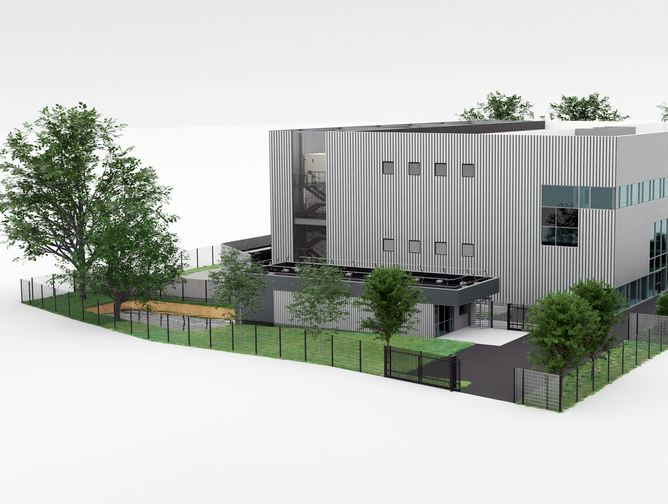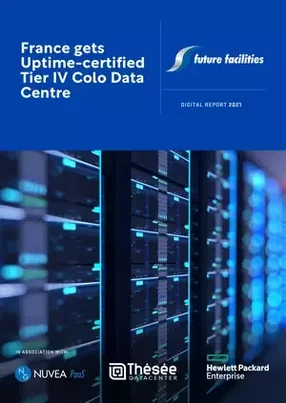Thésée DataCenter, a 100% French colocation hosting services provider –from a few bays to a complete building – has embarked on a colocation project like no other with the launch of their Uptime-certified Tier IV data centre. Located in Aubergenville, 25 minutes from Paris, Thésée is independent and neutral towards telecom operators and cloud providers, giving French-owned organisations the sovereignty they seek from a data centre. Eventually comprising six data centre buildings, each housing two identical data halls of 534 square metres, the facility is aimed at mixed-density from legacy to HPC server hosting, but in an energy-efficient manner. Each data centre hall benefits from its own 6Sigma Digital Twin from Future Facilities to ensure that capacity is managed efficiently and that it is always working at optimal efficiency from a power and cooling standpoint. Thésée has worked together with Hewlett Packard Enterprise, Future Facilities and New Generation to offer a world-first experience to its end customers with complete transparency on what is occurring in the customer’s data centre space. This is groundbreaking in terms of colocation customer experience. The secret to this customer experience comes from an end-to-end integrated Data Centre Management System (DCMS) designed by HPE, integrating solutions from Future Facilities and New Generation with all of the information accessed via a single web portal. Thésée will offer the end customer the opportunity to manage their own data centre space via a web portal with access to all alarms and performance metrics, as well as the ability to interact with a virtual replica of their 3D space and have access to CFD simulation to assess IT deployment options. The 6Sigma Digital Twin is the only CFD tool that allows data centres to optimise the design, improvement and operational planning of data centres. The 6SigmaDCX product suite, the industry's leading data centre CFD tool, is built for both data centre design and operations. Its 3D representation of the physical data centre - combined with a cutting-edge CFD (computational fluid dynamics) solver - lets data centre providers safely simulate the impact of change on a data centre’s resilience, physical capacity and cooling efficiency.
The 6Sigma Digital Twin has been used throughout the data centre design phase to validate Hewlett Packard Enterprise’s design, understand rack density limits, and simulate failure scenarios. A digital twin is essentially a 3D representation of the entire data centre and includes all its characteristics – from physical dimensions to energy consumption, giving customers a real-time, cost-effective view. Speaking further about the 6Sigma Digital Twin and its capabilities, Dave King, Product Manager of the 6SigmaDCX product suite at Future Facilities, says, “The 6Sigma Digital Twin will be used extensively by both Thésée and its customers, in the day-to-day operations of the data centre, allowing them to see a 3D virtual replica of their real-time data centre space. Customers will use insight from dashboards, reporting, and CFD simulation to make informed decisions on IT upgrades and capacity planning.”
In addition to offering digital access, the digital twin also behaves as a predictive tool with the use of CFD simulation inputs, helping customers gather insights on the data centre’s thermal environment and taking necessary measures to increase efficiency. King, who has been working with Future Facilities for the last 14 years, understands the need for this technology, adding that simulation has helped organisations make better decisions and adapting to a multi-tenant environment has brought much-needed flexibility to the customers who use these data centres.
Future Facilities has been working closely with their French reseller Wattdesign to build the digital twin model that grants almost full autonomy to the end-users of the Thésée data centre. Originally designed by HPE, Future Facilities were able to connect with Thésée on the implementation of the digital twin as a result of this collaboration. Future Facilities worked closely with partners like Wattdesign, HPE and New Generation to ensure that Thésée’s colocation centre was equipped with the latest product suite, which meant building some new integration models and adapting the software to cater for a multi-tenant environment. Thésée co-founder Christophe Bouniol, who has years of experience working in the IT space, understands the need for customer sovereignty and transparency, and so offering a French-owned data centre to its end users and implementing Future Facilities’ 6Sigma Digital Twin didn’t require a second thought. Bouniol says that high availability and increased energy efficiency are Thésée’s competitive advantage and continues to test and implement solutions that will continue to provide these benefits to his data centre facility. Speaking about the collective collaboration that helped bring the data centre to life, Bouniol adds, “At Thésée, we are proud to work with our business partners such as HPE – who helped us design our data centre, New Generation who helped us build our own portal, as well as Future Facilities and Wattdesign in France who helped realise our solution for a best in class colocation data centre.”
Thésée has worked closely with Hewlett Packard Enterprise (HPE) to build a new generation data centre (NGDC), bringing together the best in class technologies and solutions. The collaboration between HPE and Thésée is two-fold – the first being on a design and concept level, allowing HPE to choose contractors, monitor quality, implement changes and integration of the DCMS (along with partner New Generation). The second phase of collaboration focuses on the sales and business development of the data centre, allowing HPE to migrate their client roster to Thésée’s data centre. Pascal Lecoq, HPE’s Worldwide Director of Data Centre Technology Services, adds, “Thésée is a key partner for us in France to develop our service strategy, and we will go to market together in order to commercialise the software for our own customers.”
At the heart of this collaboration is New Generation, offering an enhanced customer functionality through end-to-end integration of all the systems – from DCIM and BMS to operations optimisation components – with the help of their NUVEA PaaS web service portal. New Generation has had a long-standing partnership with HPE, working together to create an integrated management solution for the data centre and its customers. Gilles Cieza, CEO and founder of New Generation, adds that this integration “facilitates the day-to-day management of the data centre operations on the customer-front and allows users to have an open and transparent dialogue with their colocation providers for the first time ever”. With the NUVEA PaaS model, Thésée’s end users will be able to log in to a single web interface to see all data centre and operating condition metrics, as well as order equipment and decide on planned upgrades. Customers will be able to see their data centre space with full equipment specifications as a 3D view, powered by the 6Sigma Digital Twin. Thésée will offer its customers the ability to simulate future capacity planning to ensure their space usage is maximised without risk.
Future Facilities’ 6Sigma Digital Twin and the innovative systems architecture combine to offer Thésée customers a truly unique experience. The use of Future Facilities’ CFD simulation via the 6Sigma Digital Twin allows both Thésée and its customers the ongoing ability to predict outcomes and make operational decisions in a cost-effective and risk-free manner whilst maximising energy and capacity efficiency. The insight offered by Future Facilities’ 6SigmaDCX product suite is crucial to the continued success of the Thésée DataCenter project. Speaking about how Future Facilities continues to adapt to the needs of the industry, King adds, “We work not only with companies running high-density AI applications but also with companies who are trying to make the most out of 25-year-old ageing infrastructure, so we have quite a large breadth of experience. So, whenever we come up against something new, we're always trying to make sure that our software adapts and evolves to allow people to simulate anything that they have in their existing data centre with our software.

- Dave King

